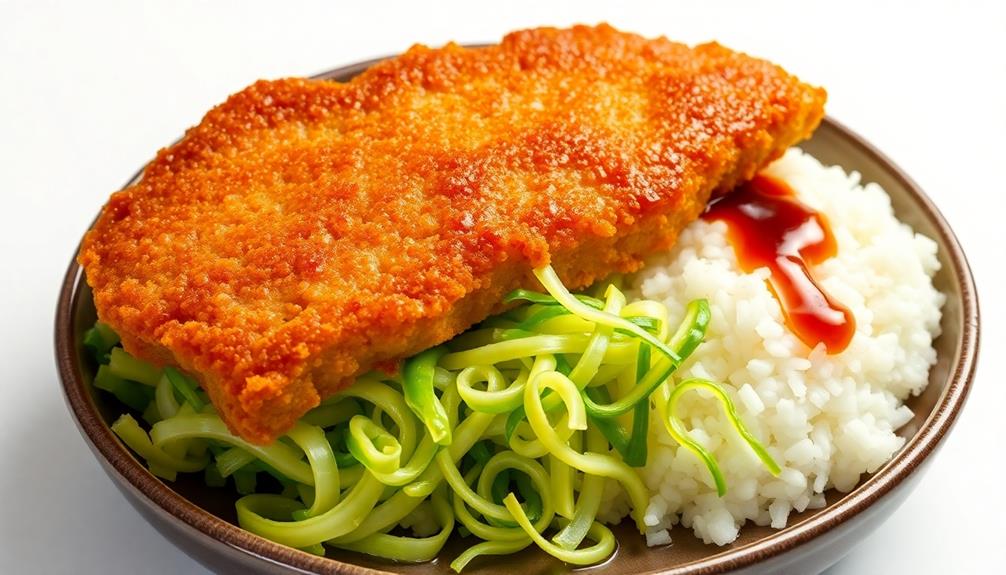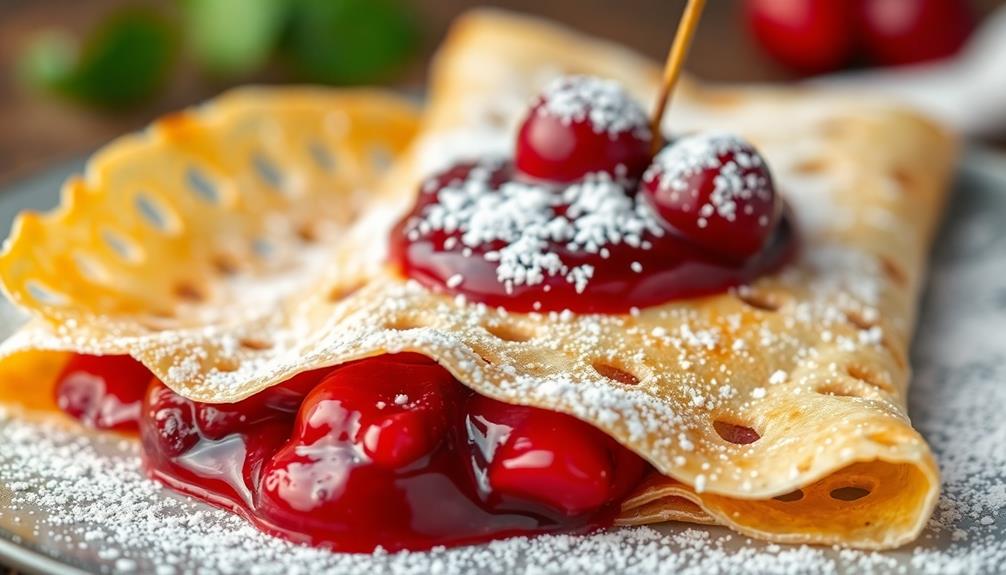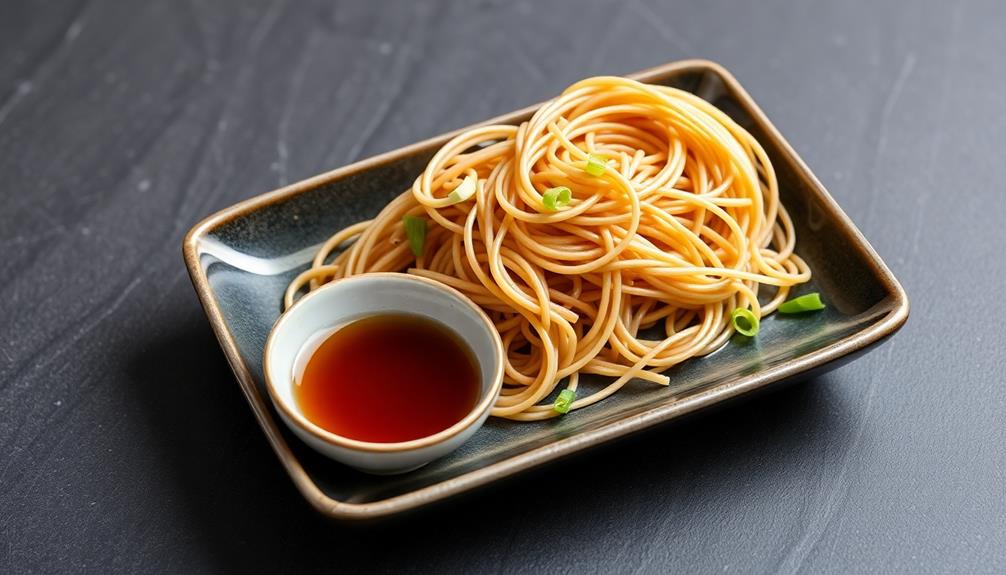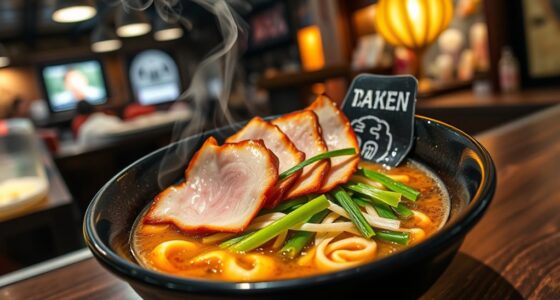You've likely heard of tonkatsu, that beloved Japanese dish of breaded and deep-fried pork cutlets. But did you know its origins trace back to the late 19th century, when Western influences started seeping into Japanese cuisine? The preparation process is quite fascinating – from pounding the meat to coating it in a crunchy panko breadcrumb shell. And the way it's served, alongside a savory sauce and fresh veggies, creates a harmonious balance of flavors. If you're curious to learn more about this iconic dish and how it reflects the evolving culinary landscape of Japan, you won't want to miss what's coming next.
Key Takeaways
- Tonkatsu is a Japanese dish of breaded and deep-fried pork cutlet, originating in the late 19th century and representing a blend of Japanese and Western culinary influences.
- The dish is typically made with pork loin or tenderloin, coated in flour, egg, and panko breadcrumbs, and deep-fried until golden brown and crispy.
- Proper techniques, such as pounding the pork to an even thickness and maintaining the oil temperature, are crucial for achieving a juicy interior and a crispy exterior.
- Tonkatsu is commonly served with a savory tonkatsu sauce, shredded cabbage, and white rice, and is enjoyed in various settings, from casual izakayas to family gatherings.
- Tonkatsu has evolved into different regional adaptations across Japan, reflecting the country's ability to embrace and innovate foreign cuisines.
History
Tonkatsu, the beloved Japanese dish of deep-fried pork cutlet, has a rich history dating back to the late 19th century. It was first introduced in Japan during the Meiji period, a time of rapid modernization and cultural exchange with the West. Inspired by Western-style fried pork dishes, Japanese chefs began experimenting with their own version, eventually perfecting the signature breading and cooking technique that we know and love today.
The name "tonkatsu" literally translates to "pork cutlet" in Japanese, reflecting the dish's simple yet delicious ingredients. The pork is carefully selected, often from the loin or tenderloin, and pounded thin before being coated in a light, crispy breading. It's then deep-fried to golden perfection, resulting in a mouthwatering combination of juicy meat and crunchy exterior.
Over the decades, tonkatsu has become a beloved staple in Japanese cuisine, enjoyed in homes and restaurants across the country. From casual diners to upscale establishments, this comforting dish continues to delight and satisfy diners with its timeless flavors and textures.
Recipe
Tonkatsu is a popular Japanese dish that features crispy, panko-breaded pork cutlets. The tender, juicy pork is a delightful contrast to the light, airy breading. This dish is often served with a tangy tonkatsu sauce, shredded cabbage, and a side of white rice, making it a satisfying and balanced meal.
To create an authentic tonkatsu at home, it's essential to follow the proper techniques. The key is to achieve a perfectly golden-brown crust that seals in the pork's natural juices, resulting in a heavenly texture in every bite.
- Pork loin or tenderloin, cut into 1/2-inch thick slices
- All-purpose flour
- Eggs, beaten
- Panko breadcrumbs
- Vegetable oil for frying
- Salt and pepper
Begin by seasoning the pork slices with salt and pepper. Set up a dredging station with the flour, beaten eggs, and panko breadcrumbs in separate shallow dishes. Dip each pork slice first in the flour, then the egg, and finally the panko, pressing gently to help the breadcrumbs adhere.
In a large skillet or Dutch oven, heat 1-2 inches of vegetable oil to 350°F. Carefully add the breaded pork slices and fry for 2-3 minutes per side, or until golden brown and crispy. Drain the cooked tonkatsu on a paper towel-lined plate.
To serve, slice the tonkatsu into strips and accompany with shredded cabbage, white rice, and a drizzle of tangy tonkatsu sauce. For best results, enjoy the tonkatsu while it's hot and crispy, savoring the satisfying contrast of textures and flavors.
Cooking Steps
First, pound the pork to your desired thickness.
Next, dredge the pork in seasoned flour, then dip it in a beaten egg mixture.
Step 1. Pound Pork to Desired Thickness

How do you achieve the perfect thickness for your tonkatsu? To get that ideal texture, you'll want to pound the pork to around 1/4 to 1/2 inch thick.
Start by placing the pork between two sheets of plastic or wax paper. Then, using a meat mallet or the bottom of a heavy pan, gently pound the pork, working from the center outwards. Apply even pressure and avoid tearing the meat. You may need to flip and pound both sides to reach the desired thickness.
The key is to be gentle but firm. You don't want to flatten the pork too thin, as that can affect the cooking time and make the texture too tough.
Take your time and check the thickness as you go, aiming for a nice, even cutlet. With a little practice, you'll be pounding pork like a pro, ready to bread and fry up the perfect tonkatsu every time.
Step 2. Dredge in Seasoned Flour
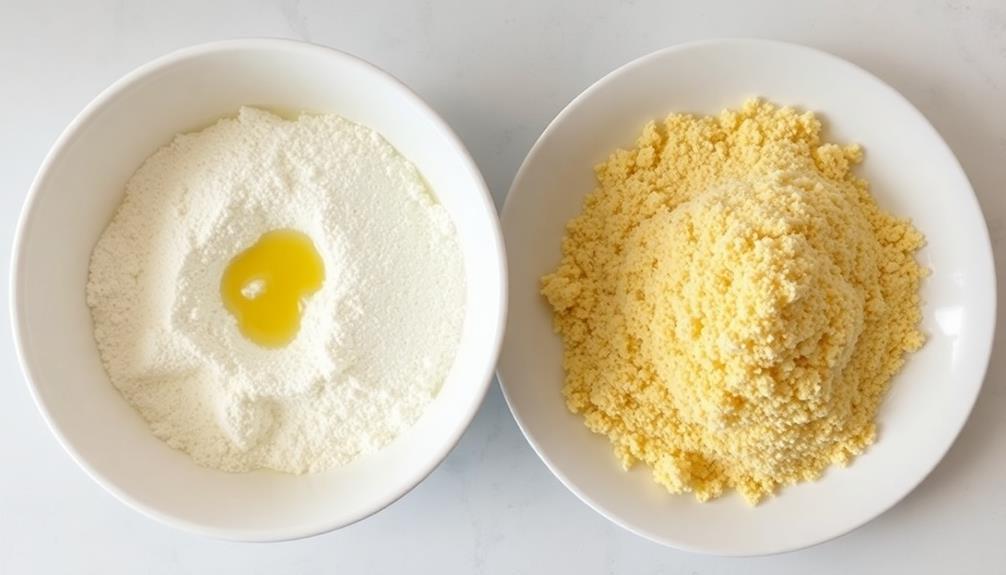
Having pounded the pork to the ideal thickness, you'll now want to dredge the cutlets in a seasoned flour mixture.
Start by gathering a shallow bowl and filling it with all-purpose flour. Add a teaspoon of salt and a half-teaspoon of freshly ground black pepper, then whisk the ingredients together to blend them evenly.
Next, take one of the pork cutlets and gently dredge it in the seasoned flour, making sure to coat both sides completely. Shake off any excess flour before setting the coated cutlet aside on a clean plate or baking sheet.
Repeat this process with the remaining pork cutlets, working in batches if needed to avoid overcrowding.
The goal is to create an even, well-seasoned coating that will become delightfully crispy when fried. Be sure to handle the cutlets gently to avoid knocking off too much of the precious flour.
With all the cutlets properly dredged, you're now ready for the next step: frying the tonkatsu to golden-brown perfection.
Step 3. Dip in Beaten Egg Mixture
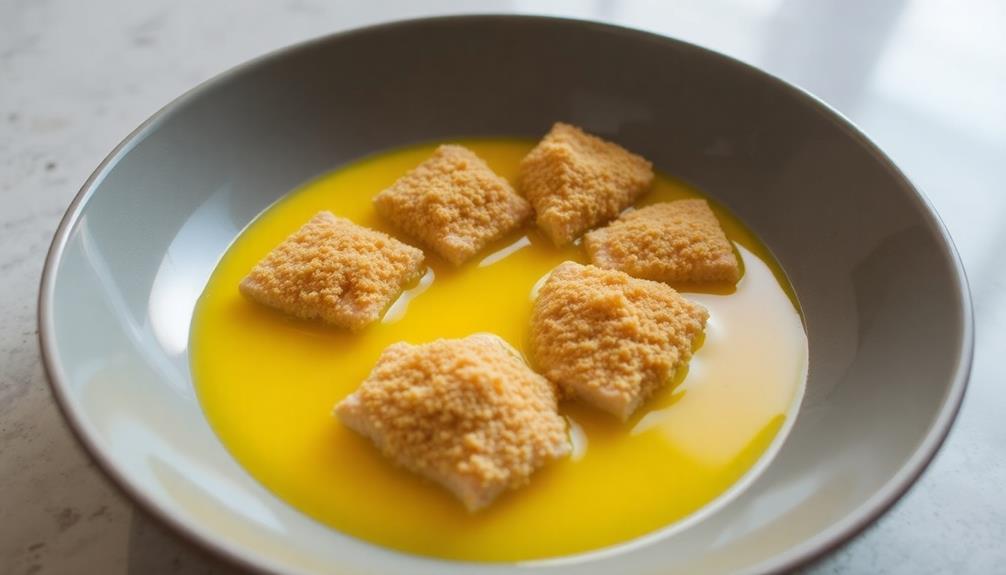
After dredging the pork cutlets in the seasoned flour, you'll want to dip them in a beaten egg mixture. This step helps the panko breadcrumbs adhere to the meat, creating a crispy, golden-brown crust.
First, crack a few eggs into a shallow dish and beat them lightly with a fork or whisk until they're well combined. You want the eggs to be smooth and homogeneous, without any visible whites or yolks.
Next, dip each floured pork cutlet into the beaten egg mixture, making sure to coat both sides evenly. Let any excess egg drip off before moving on to the next step of breading.
The egg acts as a binder, helping the panko breadcrumbs stick to the meat and creating a delicious, crunchy texture when fried.
Be sure to work in batches to avoid overcrowding the dish, ensuring each cutlet gets a thorough egg coating.
Step 4. Coat in Panko Breadcrumbs
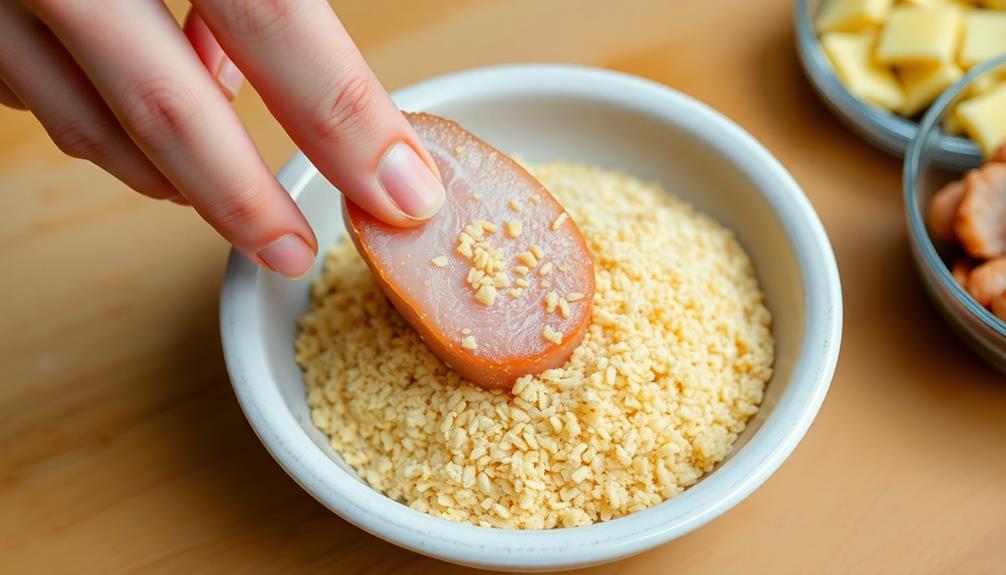
Next, thoroughly coat the egg-dipped pork cutlets in panko breadcrumbs. Panko is a type of Japanese breadcrumb that creates a light, crispy texture when fried.
Gently press the cutlets into the panko, ensuring an even coating on all sides. The key is to use enough panko to fully cover the surface of the meat, but not so much that it becomes clumpy or heavy.
Once coated, lightly shake off any excess breadcrumbs. This helps prevent the tonkatsu from becoming too greasy during frying.
Be gentle when handling the cutlets to maintain their shape and prevent the coating from falling off.
With the cutlets now breaded, they're ready for the final step of frying to golden brown perfection. This crunchy panko coating will result in a satisfying crunch with every bite of your homemade tonkatsu.
Step 5. Fry Until Golden Brown

Heat a large, deep skillet or Dutch oven with at least 2 inches of vegetable oil over medium-high heat.
Once the oil is shimmering, it's time to fry your breaded pork cutlets. Carefully lower the coated pork into the hot oil, making sure not to overcrowd the pan. Fry for 2-3 minutes per side, or until the coating is a beautiful golden brown.
Use tongs to flip the cutlets, being gentle to avoid damaging the delicate panko crust.
As the pork sizzles away, keep a close eye on it, adjusting the heat as needed to maintain an even fry. You want the outside to be crisp and crunchy, while the inside remains juicy and tender.
When the tonkatsu is ready, transfer it to a paper towel-lined plate to drain any excess oil. Repeat with the remaining cutlets, frying in batches if necessary.
With a perfectly fried tonkatsu, you're well on your way to an authentic Japanese feast!
Final Thoughts
Tonkatsu, the beloved Japanese dish, has enchanted taste buds worldwide. This crispy, golden-brown pork cutlet is the perfect balance of savory and satisfying. Many people enjoy tonkatsu with a side of shredded cabbage and a drizzle of tonkatsu sauce. The pairing of the crunchy cabbage with the juicy pork cutlet creates a delightful textural contrast. Additionally, some restaurants also offer pickled vegetables as a side, showcasing the influence of Japanese pickling traditions on the dish. These tangy and crunchy accompaniments enhance the overall dining experience and showcase the diversity of flavors in Japanese cuisine.
While the frying process may seem daunting, with the right technique, you'll be whipping up restaurant-quality tonkatsu in no time.
Remember, the key to perfect tonkatsu lies in the quality of the pork and the precision of your frying. Choose a thick, juicy pork loin and fry it to a delightful crunch. Serve it alongside a tangy tonkatsu sauce, crisp cabbage, and fluffy white rice for a meal that's sure to impress.
Tonkatsu is more than just a dish – it's a culinary experience that transports you to the heart of Japan.
Whether you're enjoying it at a family gathering or savoring it as a cozy weeknight dinner, this beloved dish is a true delight for the senses.
